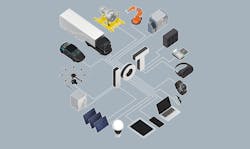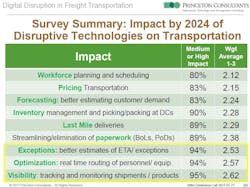Digital disruption (part 2): Analytics, analytics, analytics
While self-driving trucks and Uber-for-freight startups get much of the buzz, Princeton Consultants CEO Steve Sashihara has one word of advice for fleet executives: analytics.
“You have to drive up your analytics capabilities,” he said, speaking on a recent Stifel Capital Markets conference call. “You're going to have start moving your organizational culture to be more data-driven in how you make decisions, and rely less on experience and gut-feelings. Given the low margins in our industry, this is not a competitive advantage—this is, basically, survival.”
In Princeton’s latest industry survey, Digital Disruption in Freight Transportation, the Internet of Things (IoT)—wirelessly connected real-time sensors for everything from freight to vehicles to personnel and facilities—and Big Data topped the list as the most likely and most impactful trends.
“These are two sides of the same coin,” Sashihara said. “This is where the action is.”
In the survey, 84% of respondents agreed that IoT will have moderate or large impact, and 85% said the same for big data, or the collection and analysis of external information.
And while the labels may be trendy, Sashihara contends analytics is driving “a bona fide revolution” in manufacturing, distribution, and transportation: “everything from how we price, how we move, how we optimize, where we locate.”
“Better information means the right resources in the right place at the right time,” he said. “That’s what the buyers are buying and the sellers are selling.”
Direct spend on transportation and logistics in the U.S. is $1.45 trillion, with trucking alone shipping goods valued at $139 trillion, so the investment community sees “a lot of room” for investment in fresh ideas to make the industry more efficient, Sashihara suggests.
Interestingly, 56% of the transportation executives who took the survey agreed that digital disruption would create new winners and losers in the marketplace—but they’re not clear on how their own organizations will meet the challenges.
For existing players, the key to survival and success will be to master two types of analytics:
- Analytics at Rest: Using data to model strategic problems and opportunities, to make strategic decisions, and to develop mid- and long-term plans for profitable growth
- Analytics in Motion: Using data to optimize daily operational decisions, such as load planning, truck dispatch, and pricing
“I know that all of us have been using data for quite a while, but this is another level play,” he said. “We have to be a lot more data driven.”
About the Author
Kevin Jones 1
Editor
Kevin has served as editor-in-chief of Trailer/Body Builders magazine since 2017—just the third editor in the magazine’s 60 years. He is also editorial director for Endeavor Business Media’s Commercial Vehicle group, which includes FleetOwner, Bulk Transporter, Refrigerated Transporter, American Trucker, and Fleet Maintenance magazines and websites.

